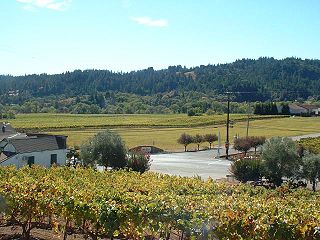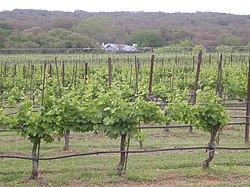
The Alexander Valley is a Californian American Viticultural Area (AVA) just north of Healdsburg in Sonoma County. It is home to many wineries and vineyards, as well as the city of Cloverdale. It is the largest and most fully planted wine region in Sonoma. Highway 101 runs through the valley, and the Russian River flows down the valley, surrounded by vineyards on both sides. From the higher elevations of the valley rim, there is a view as far south as Taylor Mountain and Sonoma Mountain. The region was named for Cyrus Alexander, owner of a part of the Rancho Sotoyome Mexican land grant, in 1847. Granted AVA status in 1984, the boundaries of the appellation are defined in the Code of Federal Regulations, Title 27, Section 9.53.
The state of Oregon in the United States has established an international reputation for its production of wine, ranking fourth in the country behind California, Washington, and New York. Oregon has several different growing regions within the state's borders that are well-suited to the cultivation of grapes; additional regions straddle the border between Oregon and the states of Washington and Idaho. Wine making dates back to pioneer times in the 1840s, with commercial production beginning in the 1960s.

The Willamette Valley AVA is an American Viticultural Area which lies in the Willamette Valley of Oregon. The AVA is the wine growing region which encompasses the drainage basin of the Willamette River. It stretches from the Columbia River in the north to just south of Eugene in the south, where the Willamette Valley ends; and from the Oregon Coast Range in the west to the Cascade Mountains in the east. At 5,360 square miles (13,900 km2), it is the largest AVA in the state, and contains most of the state's wineries; approximately 908 as of 2021.

The Applegate Valley AVA is an American Viticultural Area located in southern Oregon. It is entirely contained within the Rogue Valley AVA, which is itself included within the larger Southern Oregon AVA. The region is named for the Applegate River, which flows through the town of Applegate and near the city of Jacksonville. The Applegate Valley has been a grape-growing region since 1870 when A. H. Carson began planting 30 acres of grapes along North Applegate Road. One of Oregon's first wineries was established in the Applegate Valley. This region contains vineyards at altitudes ranging from 1,000 feet (300 m) to 1,500 feet (500 m) above sea level, and is warmer and drier than the Illinois Valley to the west, but less so than the Bear Creek Valley to the east. Grapes that thrive here include Tempranillo, Merlot, Cabernet Franc, Cabernet Sauvignon, Syrah, Tannat, Vermentino, Chardonnay, and Zinfandel.

The Dundee Hills AVA is an American Viticultural Area located in Yamhill County, Oregon. It is entirely contained within the Willamette Valley AVA, and is approximately 28 miles (45 km) southwest of Portland, near the towns of Dundee and Dayton. The area is 6,940 acres (2,809 ha) in total size, with 1,300 acres (526 ha) planted with grapes. The Dundee Hills are a north-south oriented line of hills on the western side of the Willamette River valley. The soil is red in color, rich in iron, relatively infertile, making it suitable for grape cultivation. The region gets 30 inches (76 cm) to 45 inches (114 cm) of rainfall per year. The Chehalem Mountains to the north protect the region from the cool breezes that enter Willamette Valley from the Columbia Gorge. Over 25 wineries and independent vineyards in this region produce over 44,000 cases of wine.

Horse Heaven Hills is an American Viticultural Area (AVA) in southeastern Washington lying in portions of Klickitat, Yakima, and Benton counties, north and west of the Columbia River and south of the Yakima Valley and lies within the vast Columbia Valley appellation. Horse Heaven Hills was established by the Alcohol and Tobacco Tax and Trade Bureau {TTB), Treasury on June 30, 2005 after reviewing the petition filed by Paul D. Lucas on behalf of regional wine grape growers. Horse Heaven Hills viticultural area is about 60 miles (97 km) long and 22 miles (35 km) wide located 115 miles (185 km) east from Vancouver, Washington. The appellation encompasses 570,000 acres (891 sq mi) with about 6,400 acres (2,590 ha) under vine.

Rattlesnake Hills is an American Viticultural Area (AVA) located in Yakima County, Washington surrounding the Rattlesnake Hills. The appellation is the state's 9th AVA established on March 20, 2006 by the Alcohol and Tobacco Tax and Trade Bureau {TTB), Treasury after reviewing the petition submitted by Mr. Gail Puryear, Bonair Winery owner, along with 10 other vineyard and winery owners in the region proposing the "Rattlesnake Hills" viticultural area. The 68,500 acres (107 sq mi) Rattlesnake Hills AVA boundaries are within the Yakima Valley AVA as both are encompassed by the vast Columbia Valley AVA. Rattlesnake Hills borders the northern boundary of Yakima Valley including land between the north bank of the Sunnyside Canal and the entire southern boundary slopes are between Outlook and the Wapato Dam. The western boundary meanders on a east-west chain of hills north of I-82 passing through the cities of Parker, Donald, Buena and Zillah while just east of the Yakima River. Rattlesnake Hills rises to the highest point in the Yakima Valley with elevations ranging from 850 to 3,085 feet (259–940 m).

The Augusta AVA was established on June 20, 1980 as the first federally approved American Viticultural Area, eight months before the Napa Valley AVA in northern California. The petition was submitted by Clayton W. Byers and Lucian W. Dressel, representing the local wine industry, to the Director of the Bureau of Alcohol, Tobacco and Firearms on October 16, 1978. Located entirely within the state of Missouri, the boundaries of this wine region encompass 15 square miles (39 km2) around the city of Augusta near the intersection of St. Charles County, Warren County and Franklin County.

Sonoma County wine is wine made in Sonoma County, California, in the United States.

The Dry Creek Valley AVA is an American Viticultural Area in Sonoma County, California, located northwest of the town of Healdsburg. The valley is formed by Dry Creek, a tributary of the Russian River, and is approximately 16 miles (25.7 km) long and 2 miles (3.2 km) wide. The appellation benefits from the proximity of the Lake Sonoma reservoir for irrigation in this relatively dry area.
The Northern Sonoma AVA is an American Viticultural Area in Sonoma County, California, United States. The appellation covers most of the county with the notable exceptions of the Los Carneros AVA and Sonoma Valley AVA wine regions, which are located in the southern portion of the county. The creation of this AVA was largely based on the petitioning of the E & J Gallo Winery as part of their expansion of their Gallo of Sonoma brand. The viticultural area incorporates the Alexander Valley AVA, Chalk Hill AVA, Dry Creek Valley AVA, Knights Valley AVA, Russian River Valley AVA, Sonoma Coast AVA, and parts of the Green Valley of Russian River Valley AVA and Rockpile AVA valleys.

The Texas High Plains AVA is an American Viticultural Area located on the Llano Estacado region of Texas. The appellation is the second largest American Viticultural Area in Texas, and covers an area of over 270,000 acres (422 sq mi). Most of the vineyards are on flat terrain at elevations between 3,000 feet (914 m) and 4,000 feet (1,219 m) above sea level. The Texas plains can be extremely dry, so most vineyards are irrigated with water from the Ogallala Aquifer. The hardiness zones are 7a and 7b.

The Fredericksburg in the Texas Hill Country AVA is an American Viticultural Area surrounding the town of Fredericksburg, Texas in the Texas Hill Country.
The Bell Mountain AVA is an American Viticultural Area located in Gillespie County, Texas. It was the first designated wine area located entirely in the state of Texas, and covers an area of over 3,200 acres (5 sq mi). The appellation is entirely contained within the Texas Hill Country AVA, which was established nine years after Bell Mountain AVA. As of 2006, there were nine wineries in the appellation.
The Escondido Valley AVA is an American Viticultural Area located in Pecos County, Texas. It was the fifth designated wine area in the state of Texas, and covers an area of over 32,000 acres (129 km2). There are no wineries located in the Escondido Valley AVA. The largest winery making Escondido Valley AVA designated wines was Ste. Genevieve Wines, whose winery facilities were located near Fort Stockton. Mesa Vineyards, owners of the Ste. Genevieve Winery, filed for bankruptcy in January 2022.
The Mesilla Valley AVA is an American Viticultural Area located primarily in the state of New Mexico with a small area in the state of Texas. Spanish explorer Don Juan de Oñate arrived in the area in 1598 and named a Native American village in the valley Trenquel de la Mesilla, from which the valley as a whole became known as Mesilla Valley. Although viticulture began in nearby El Paso as early as 1650, grapes were first planted in the Mesilla Valley only in the early twentieth century, near the town of Doña Ana. The climate in the Mesilla Valley is dry and hot.
The Texoma AVA is an American Viticultural Area located in north central Texas, on the south side of Lake Texoma and the Red River that forms the border with the state of Oklahoma. The Texoma region is where 19th century viticulturist Thomas Volney Munson discovered that grafting Vitis vinifera grapevines onto native American varieties of vine rootstock resulted in vines that were resistant to phylloxera. The technique saved the European wine industry when it was brought to France, which was suffering its first phylloxera epidemic. The region was not designated an American Viticultural Area until 2005.

Sta. Rita Hills is an American Viticultural Area located in Santa Barbara County, California. From its creation in 2001 through 2006, the wine appellation was officially named Santa Rita Hills AVA. The formal name change was the result of a protest by and subsequent negotiations with Vina Santa Rita, a very large Chilean wine producer that was concerned about the AVA name diluting its international brand value. The name change took effect on January 5, 2006, with a yearlong period for producers in the AVA to change their wine labels. In 2016, TTB expanded the approximately 33,380 acres (52 sq mi) “Sta. Rita Hills” viticultural area by approximately 2,296 acres (4 sq mi).

The Hermann AVA is an American Viticultural Area located in Gasconade County, Missouri, and entirely contained within the larger Ozark Mountain AVA. The wine appellation is located on the southern side of the Missouri River near the town of Hermann, about halfway between St. Louis and Jefferson City. The AVA covers the northernmost hills of the Ozark Plateau with many of the 200 acres of vineyards planted along hillside locations. As of 2007, seven wineries were producing wine in appellation, including Missouri's largest winery, Stone Hill Winery.
The Warren Hills AVA is an American Viticultural Area located in Warren County, New Jersey. The Warren Hills region includes several small valleys formed by tributaries of the Delaware River. The valleys drain from northeast to southwest, and most vineyards in the area are planted on southeast-facing hill slopes. The region is primarily planted with French hybrid grapes. It has a hot-summer humid continental climate (Dfa) and is located in hardiness zones 6b and 7a.












